Seeing the famous bowing deer of Nara is a highlight of many Japan itineraries. We’re sharing everything you need to know about visiting Nara Deer Park, including insider tips and what not to do.
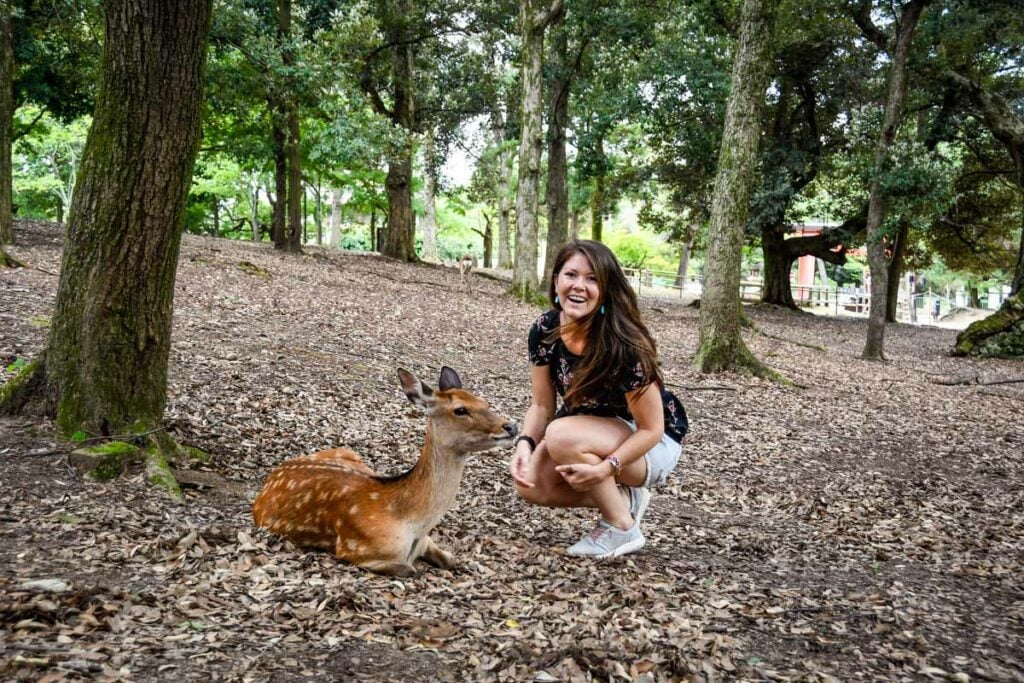
If you’ve seen pictures or videos of the famous bowing deer in Japan, you may have some questions…
Like: Why the heck are there deer in this city in the first place?!
Or, Where can I see the deer with fewer crowds?
Lucky for you, we’ve got answers.
We’ve visited Nara twice – in 2019 and again in 2023 – and learned a lot on both of our visits.
Get ready for some fun facts about the Nara deer, tips for visiting Nara Deer Park, and answers to all your nagging questions!
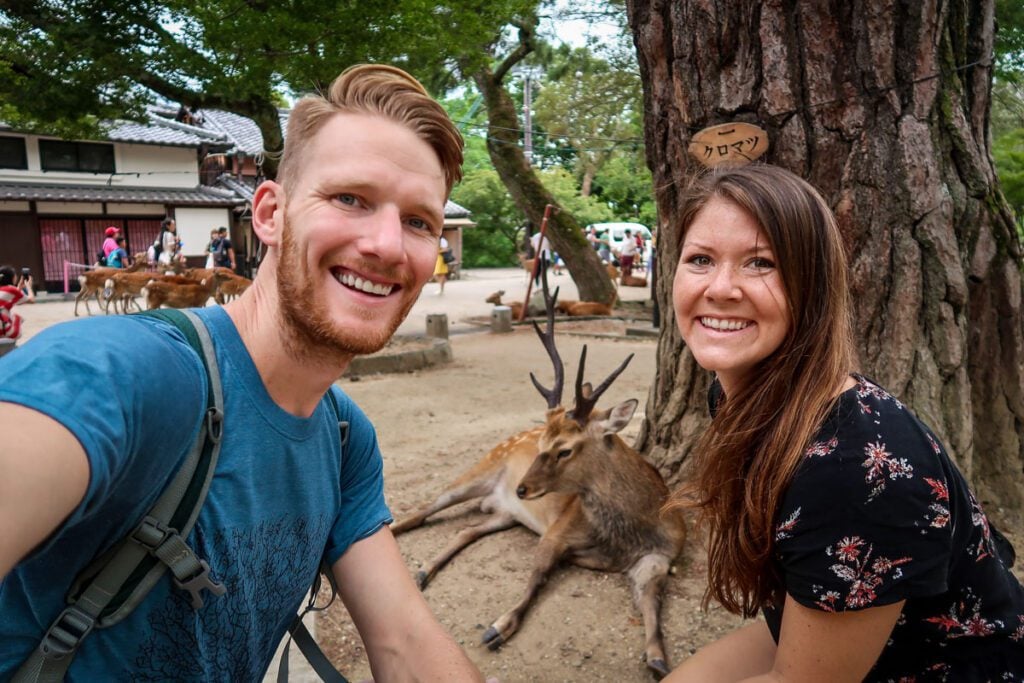
Don’t miss this! We think that Nara makes a wonderful day trip from Kyoto or Osaka, and we’ve put together what we think is the perfect Nara day trip itinerary. Be sure to check it out because we’ve done all the planning for you (including where to eat and a famous sweet shop you can’t miss!).
Nara Deer Park Guide
- Fun facts about Nara deer
- How to feed the deer
- Best places to see deer in Nara
- Best time to visit
- Nara deer FAQs
Fun Facts about the deer in Nara
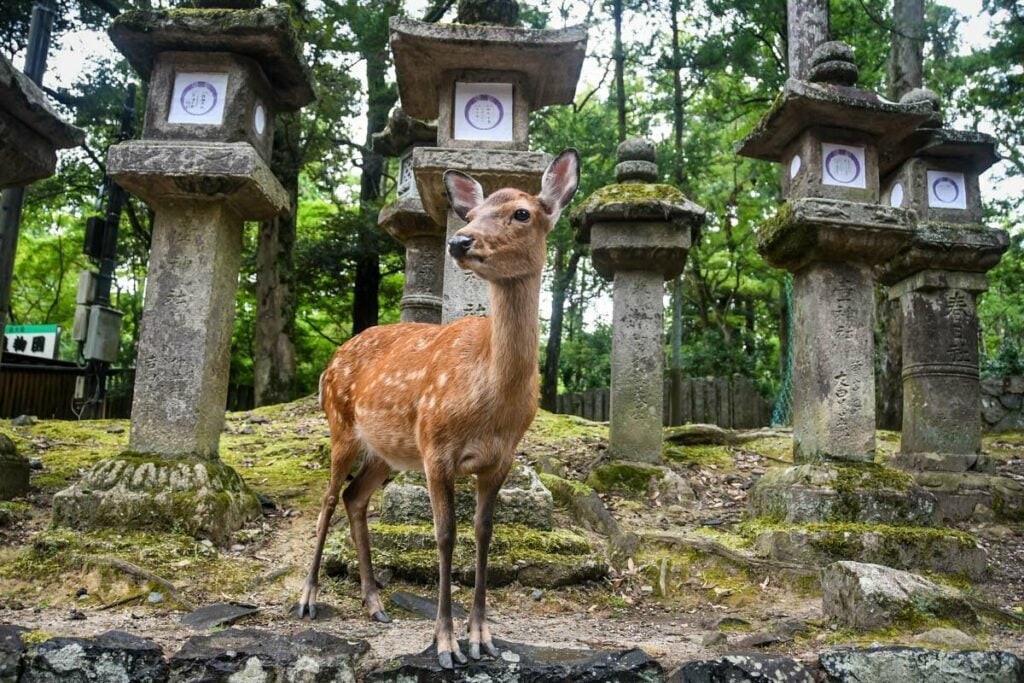
There’s a lot more to the famous Nara deer than cute photos and bowing for crackers. This website has a ton of info if you really want to get your science geek on, but here are a few fun facts to get started.
They’re a species called “sika”.
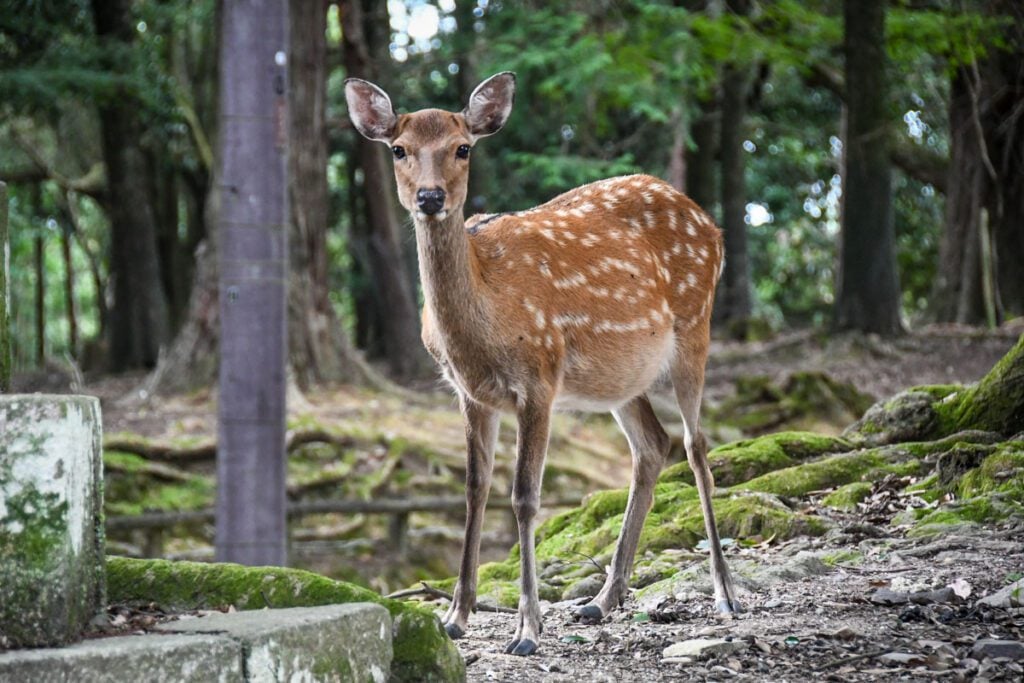
When we talk about deer in North America, we’re usually referring to whitetails (like Bambi), or maybe reindeer (thanks, Rudolph!). But that’s not what you’ll find in Nara Park.
Sika deer are smaller with stout bodies and shorter, spindly legs. Males tend to weigh around 88-154 lbs and measure up to 3.6 ft high at the shoulder, while females are usually 66-88 lbs and as little as 2.1 feet.
While not slender and elegant like a whitetail or majestic like an elk, the little sika deer are stinkin’ adorable!
Nara’s sika deer are genetically unique.
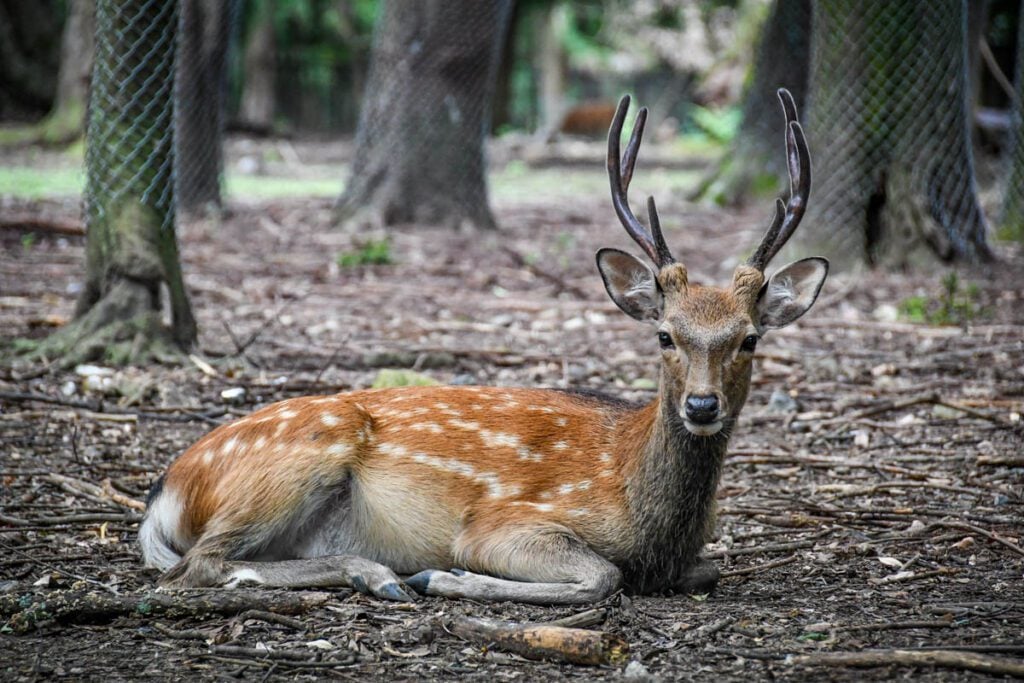
Research suggests that the deer in Nara Park may have genetic differences from sika deer elsewhere in Japan.
This study of Japanese deer found that Nara deer possess a unique genotype, believed to have been preserved through centuries of conservation, whereas other sika populations were threatened by hunting and habitat destruction.
Nara deer are sacred.
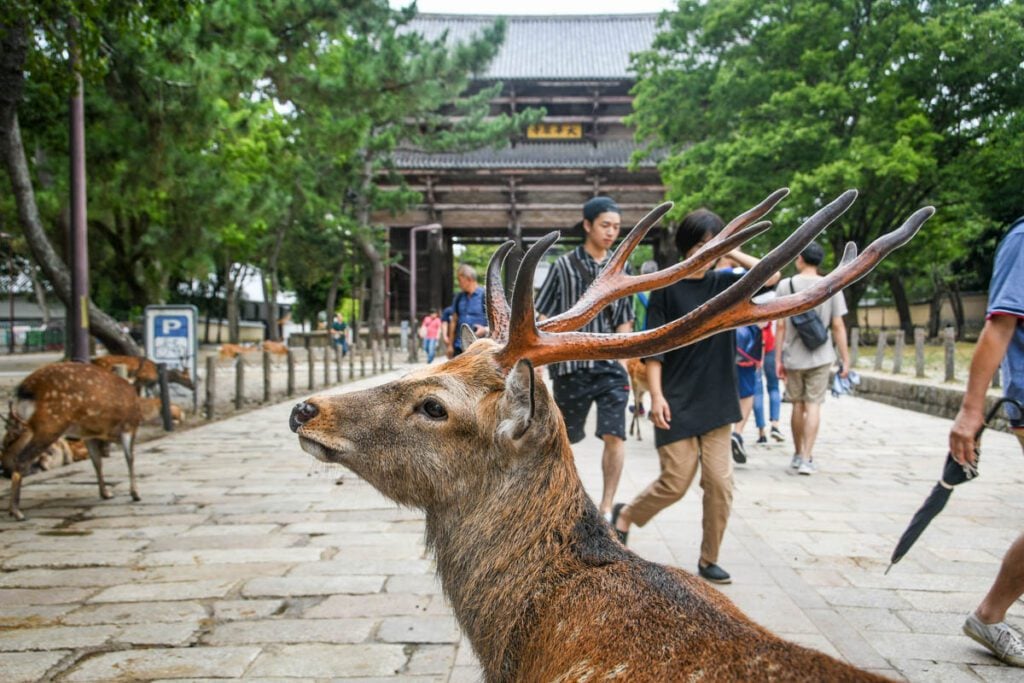
According to Shinto tradition, the deer who populate Nara are sacred messengers of the gods.
The belief comes from a legend that says the god Takemikazuchi-no-mikoto rode from Ibaraki Prefecture (just north of Tokyo) all the way to the top of Nara’s Mt. Mikasa on the back of a white deer.
They’re also protected by law.
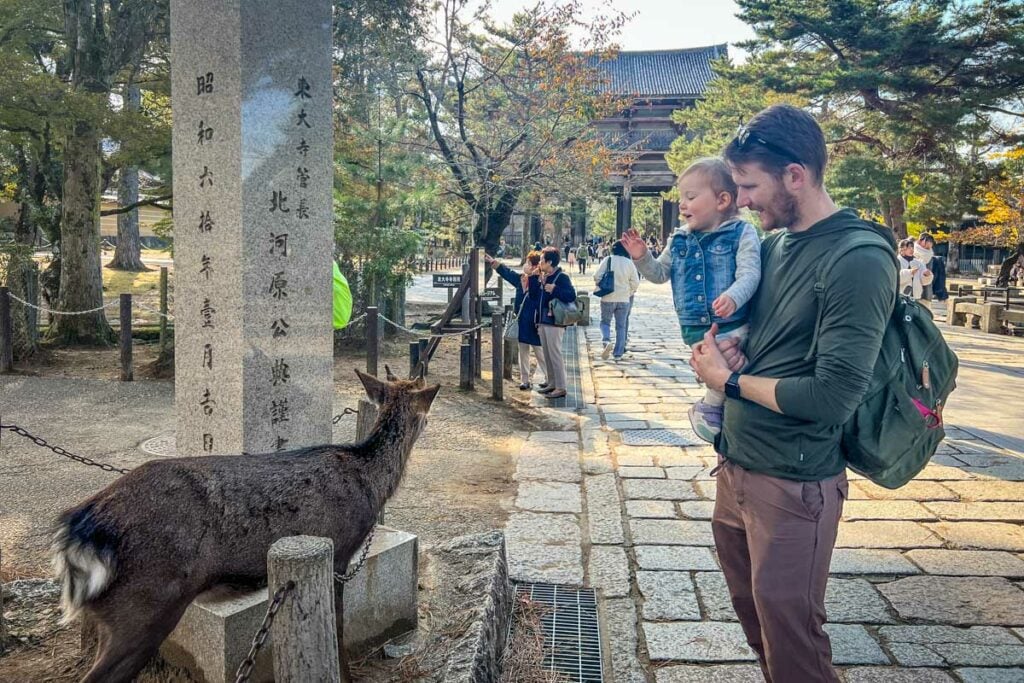
Until 1637, killing a Nara deer was a crime punishable by death – decapitation, to be precise.
Though no longer a capital offense, the deer are still protected Natural Monuments under Cultural Assets Law. Killing or harming one today can result in fines or jail time.
Deer crackers are called shika senbei.
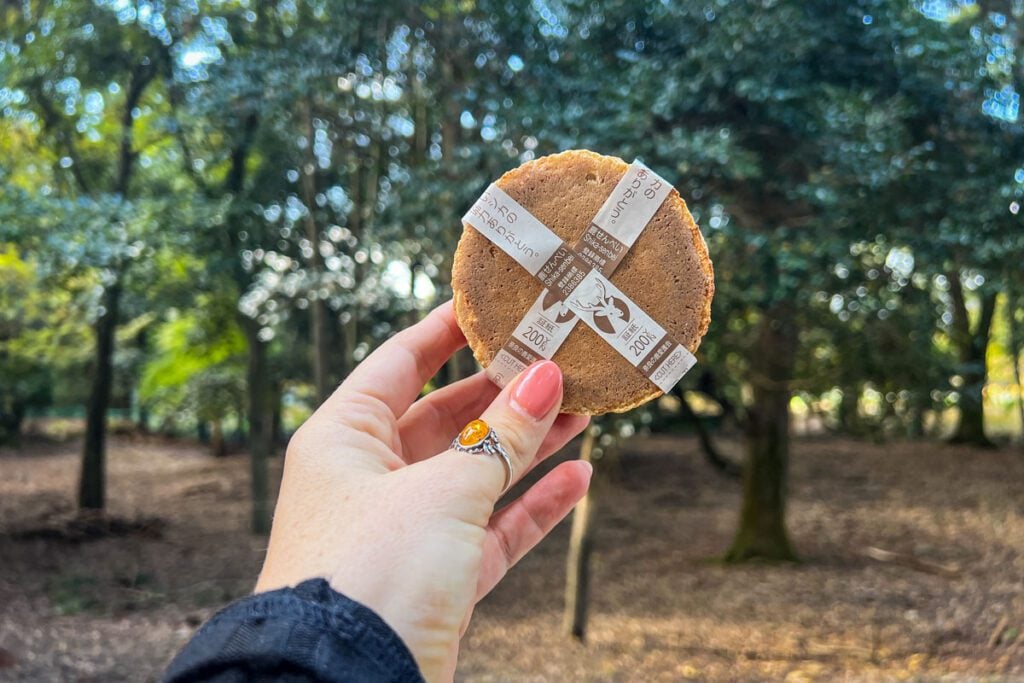
All over Nara Park, you’ll see vendors selling these crackers to tourists to feed the deer. More on that in the next section!
Insider Tip: Search for deer designs everywhere throughout town. Even the manhole covers in Nara have deer on them!
How to feed the deer in Nara
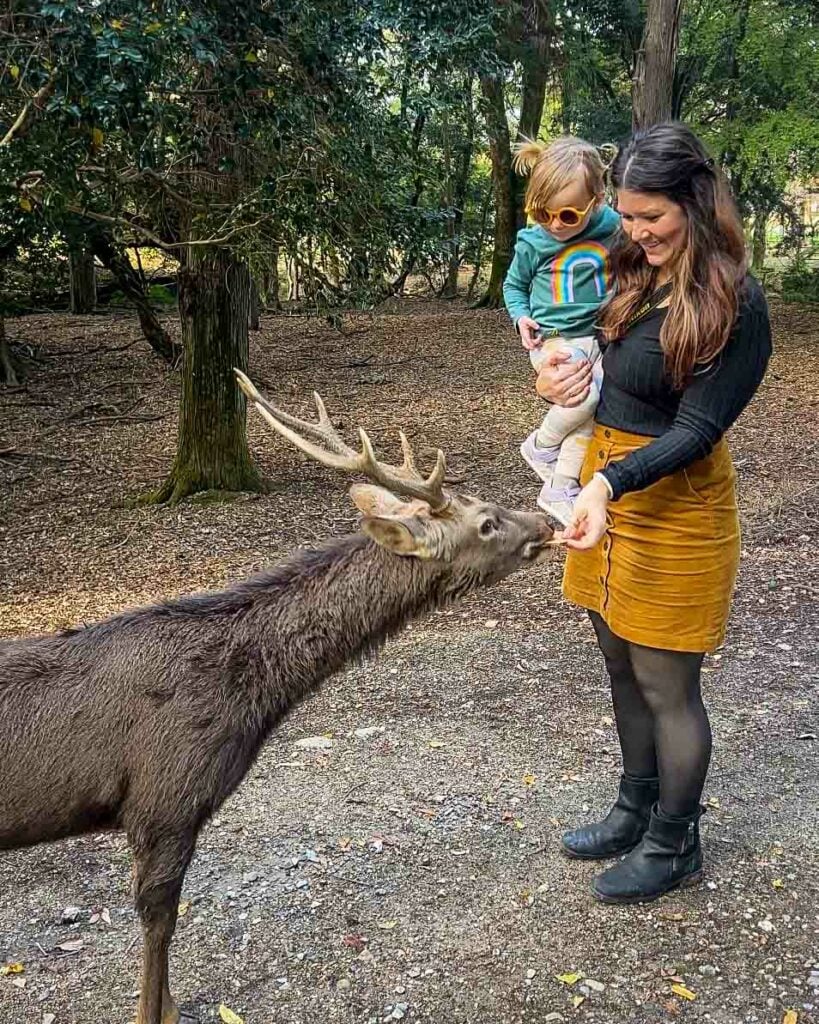
If you plan to feed the deer in Nara, please read these tips first:
1. Purchase deer crackers
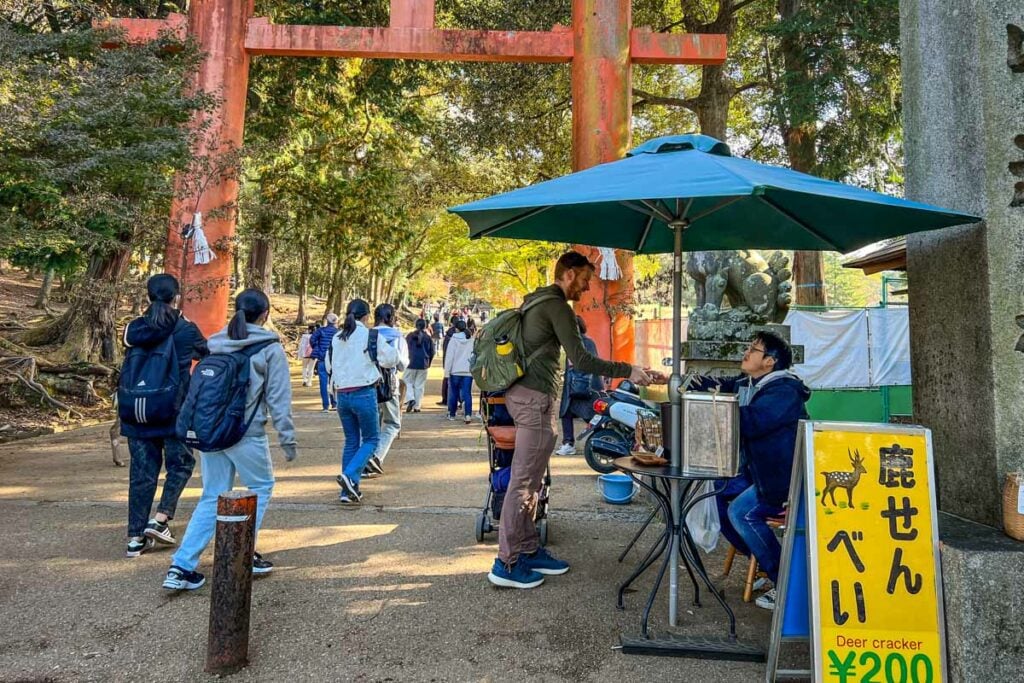
You’ll see stands scattered throughout Nara Deer Park, and they’re all relatively the same.
Deer crackers are made of wheat flour and rice bran and are sold in packs of ten for ¥200.
The Foundation for the Protection of Deer in Nara makes the crackers, and a portion of the profits goes toward protecting the deer.
2. Don’t feed them anything other than deer crackers
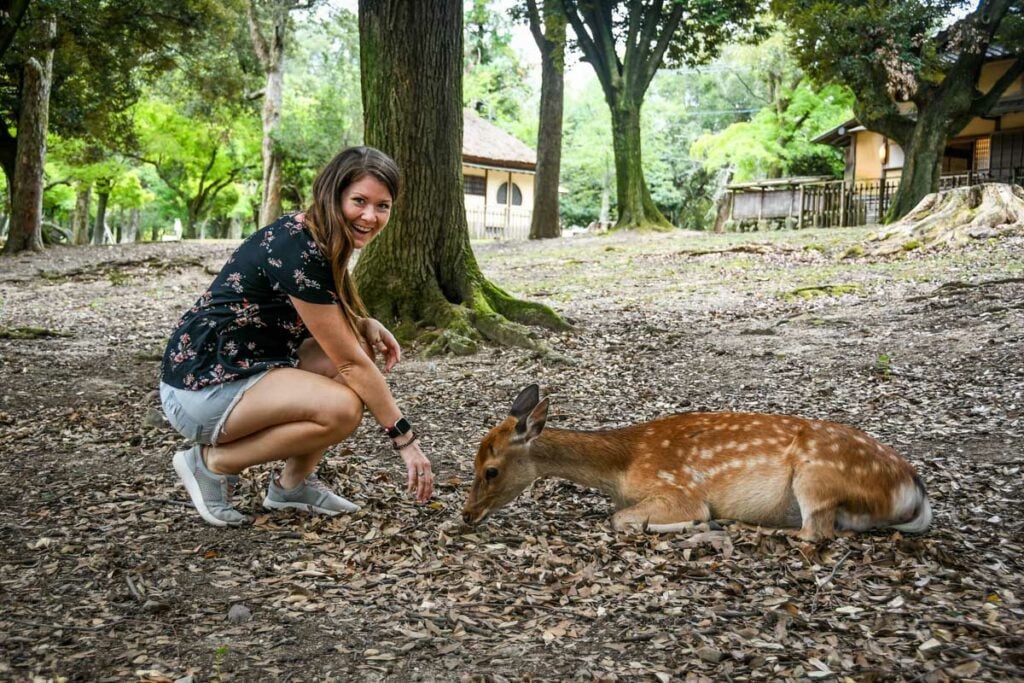
The deer crackers are made with wheat flour and rice bran and have been formulated specifically for the deer. (Even the wrapping paper is said to be safe for the deer in case they accidentally consume it.)
It is important that you do not offer them anything other than the crackers.
3. Don’t bring other food into the park
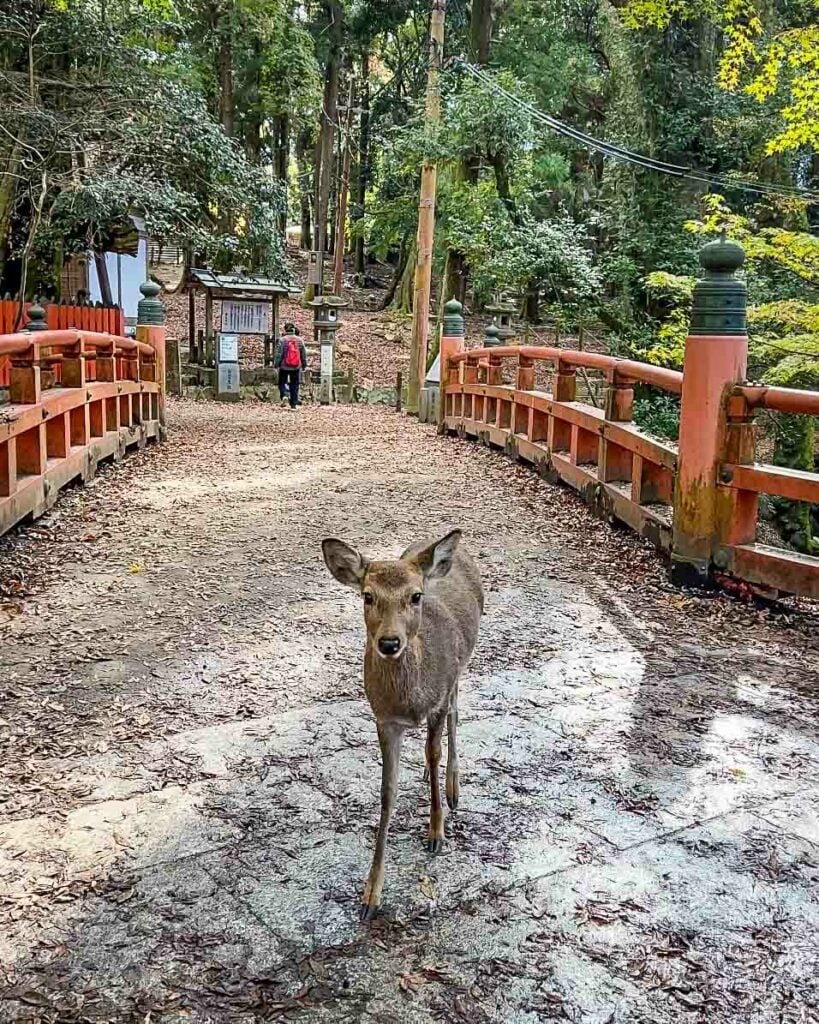
If you have other food on you, be sure to secure it inside a bag. Don’t take it out until you are far from any deer.
Good to know: In Japan, it is considered rude to walk and eat, so you should not be snacking on the go anyway.
4. Remember they are wild animals
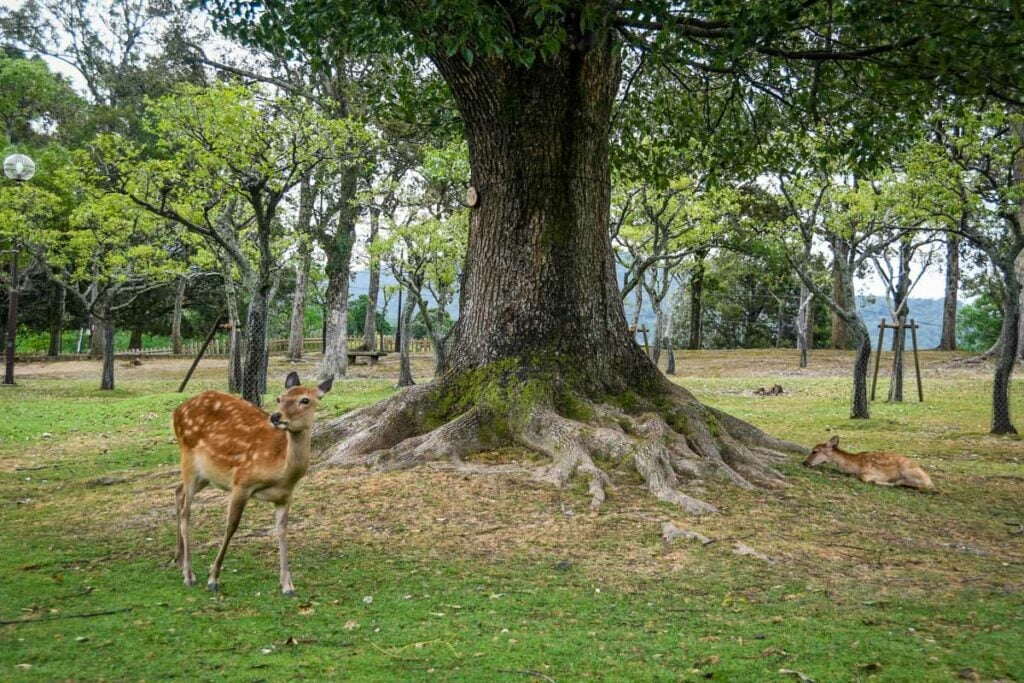
I will back up and say wild-ish, because they do rely a lot on people feeding them. However, they are not trained and they behave as they’d like, so keep this in mind.
We would advise you don’t pet them, even though it may be tempting.
5. Wait for the deer to bow
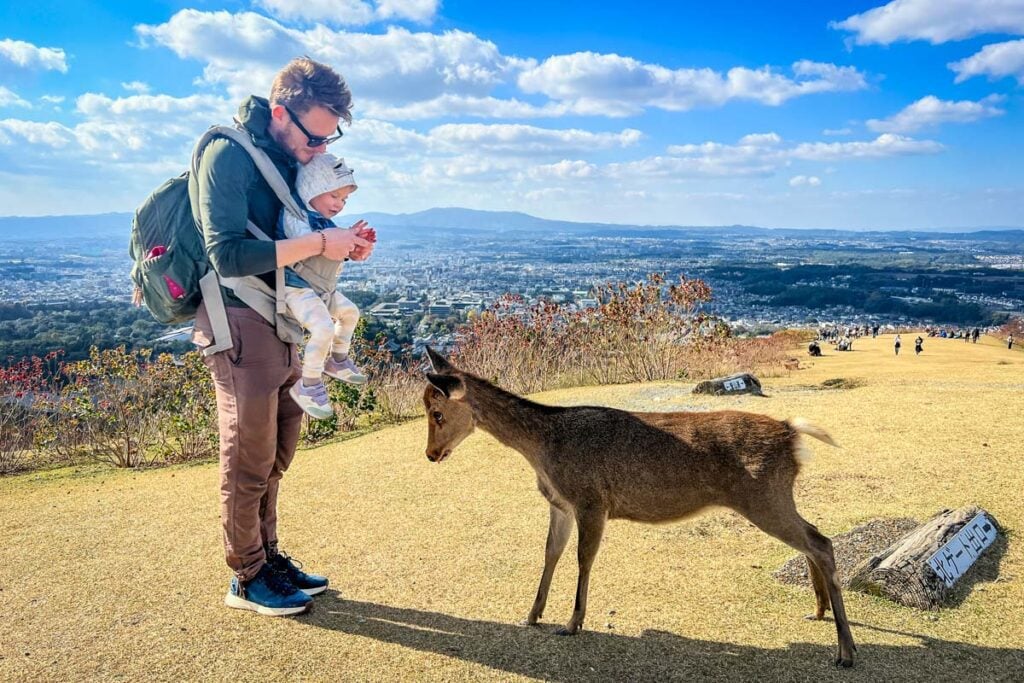
The deer in Nara actually know how to bow for crackers, and there is kind of a rhyme and reason to it.
It is said that you should wait for them to bow three times before giving them a cracker.
So how do you get them to bow? Glad you asked!
- First, hold the cracker above their head and wait for a bow.
- Then, hold the cracker behind your back so it bows a second time.
- Hold it overhead one last time before placing it in their mouth (or just holding it out allowing them to grab it away).
Don’t fret too much if they don’t bow three times, and be prepared for some of the deer to go straight for the cracker. Just like people, they have their own personalities, and some are more patient and well-mannered than others.
6. Don’t tease them
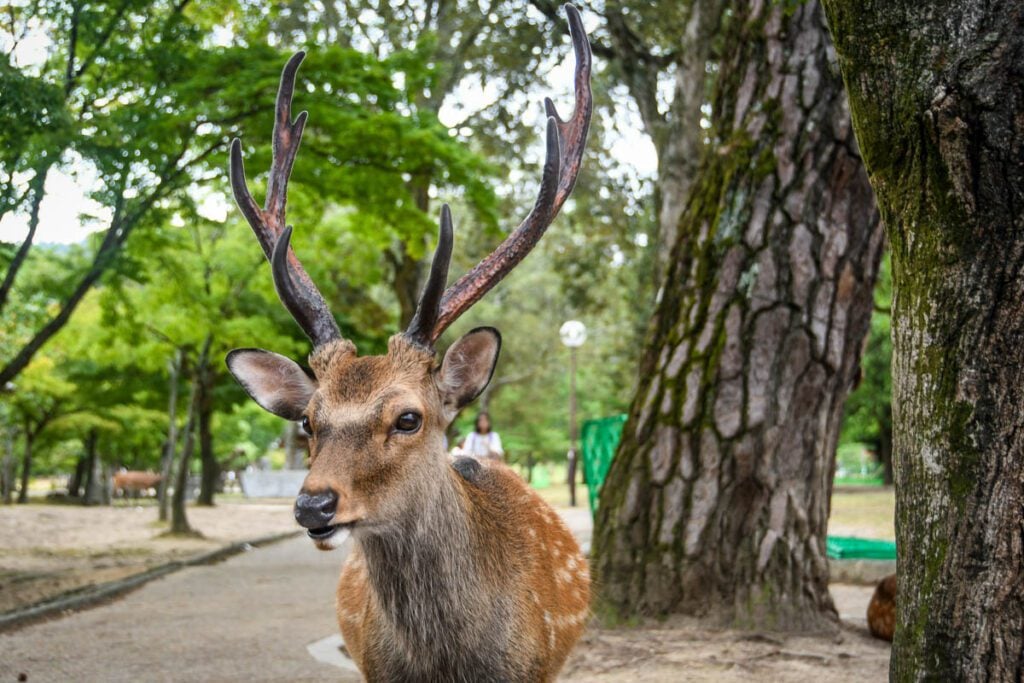
After they bow three times, give them the cracker. Don’t take it away or tease them with it. This can lead them to becoming aggressive; plus, it’s just not nice.
7. Feed them earlier in the day
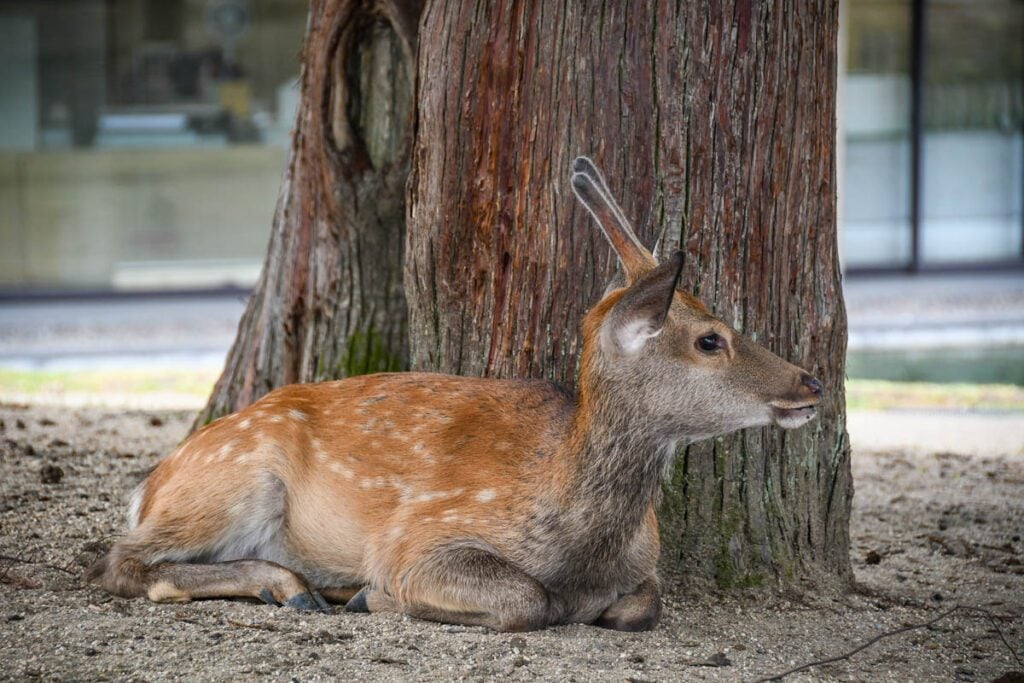
We noticed that many deer didn’t want crackers later in the afternoon.
It seemed like they had already gotten as much as they wanted and weren’t interested in crackers. If feeding them is important to you, keep this in mind.
8. Be mindful about which deer you feed
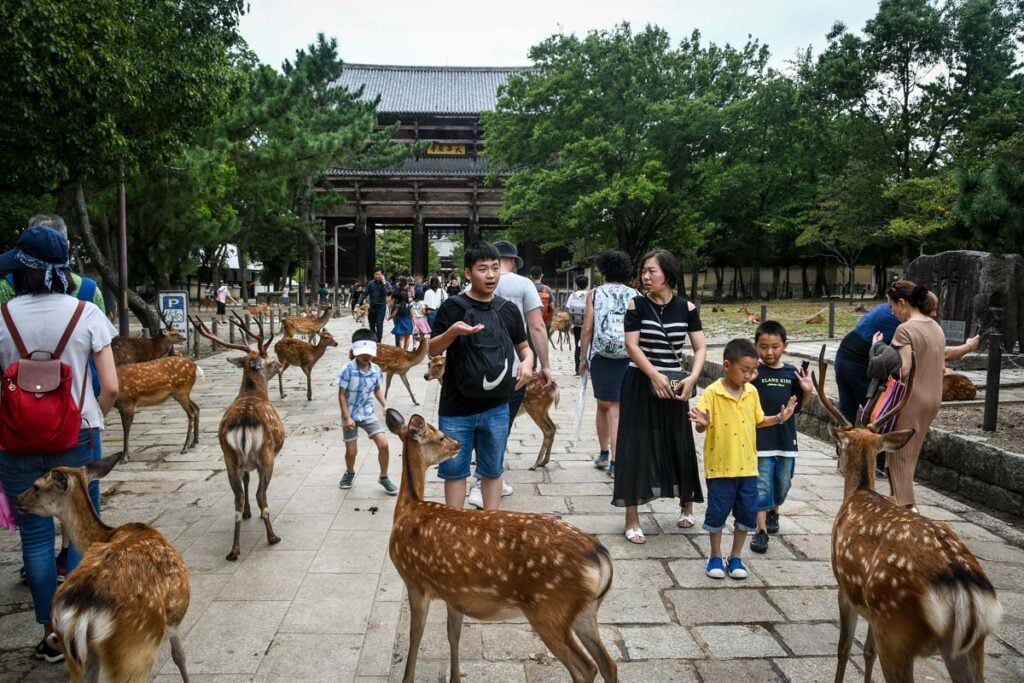
Personally, I would advise getting off the main walking street before feeding deer because the ones that hang around the most crowded parts tend to be more aggressive and are fed more often.
We had much better experiences with the deer that were wandering in open spaces of the park.
Psst! Jump down to some places where you can see the deer without tons of people around.
9. You can still have a great time without feeding them
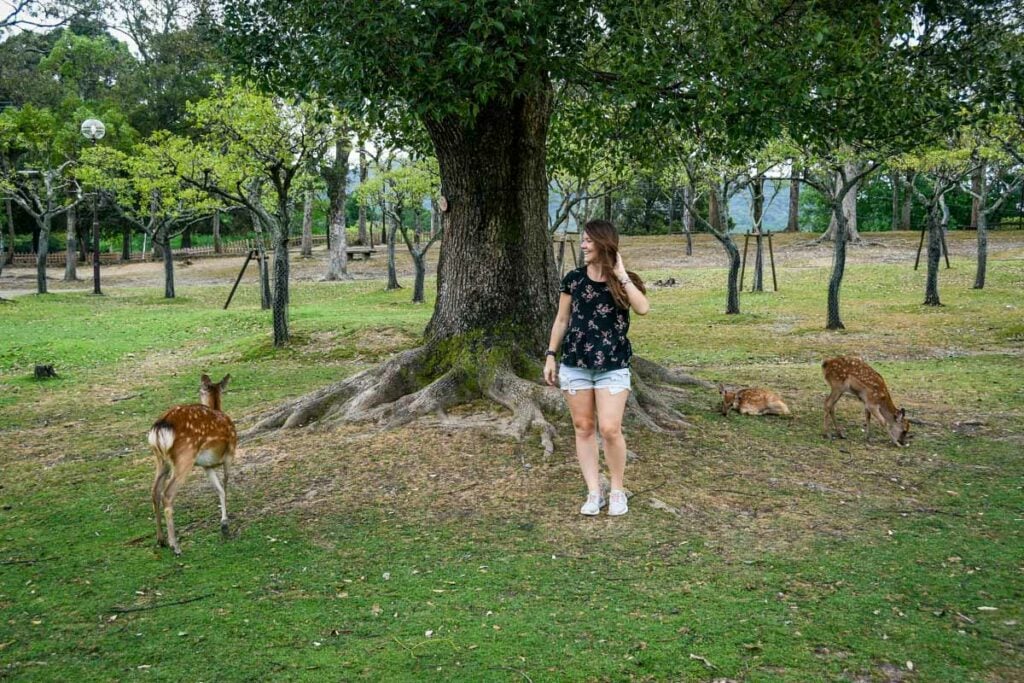
I am wary of any animal experience that involves feeding. During our first visit to Nara, we chose not to feed the deer and we still had a great time.
You can still get deer selfies and see them up close, and you’ll undoubtedly see them bow to other people who are feeding them.
We did purchase a pack of crackers on our second visit because we were traveling with our daughter (who was 2 years old at the time), and it made it a little more interactive for her.
Best places to see deer in Nara

In truth, I would say that you can simply wander into Nara Deer Park and head toward the open, grassy spaces to get away from the crowds. The deer are everywhere and their locations change by the minute, so it’s hard to give definitive locations.
However, I also understand that sometimes it’s easier to put a pin into Google Maps and head toward it as a starting point.
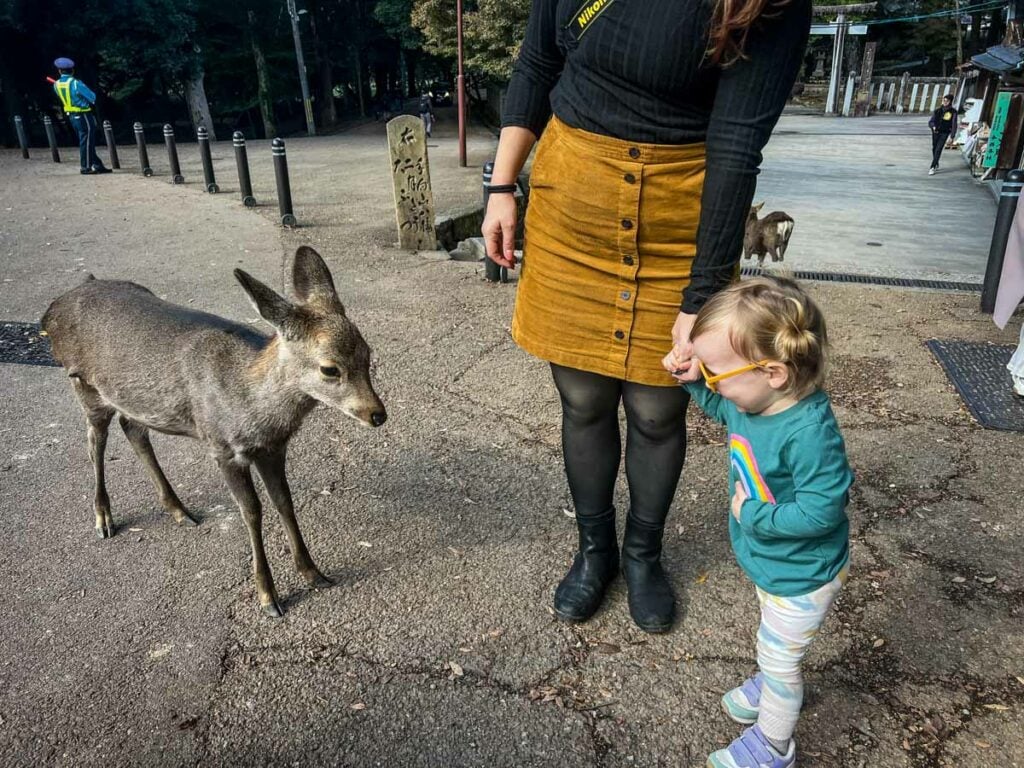
Here are a few general areas that we’ve been able to have a peaceful experience with the deer (away from the crowds):
- Large grassy area in Nara Deer Park: This is pretty much the center of the large grassy area, and makes a great first stop.
- Near the Funagata Rest Shelter: Just across the small street from the stop listed above, we’ve seen lots of deer here and few other people.
- Tobihino: South of the main part of Nara Deer Park, this area tends to be less busy
- Kasuga Taisha: This area is near a shrine and is a particularly stunning place to see deer.
- Mount Wakakusa: Hiking up this hill offers beautiful vistas over town as well as a handful of deer that hang out in this far less crowded area, making it a unique place to see them.
Where not to see the deer: One area that I’d recommend bypassing is the walking street that runs north of this intersection. I’m not saying you need to avoid it – it is centrally located and there’s a good chance you’ll walk through. But don’t spend too much time here as it gets very crowded and the deer seemed overfed here during our visit.
Best time to visit Nara Deer Park
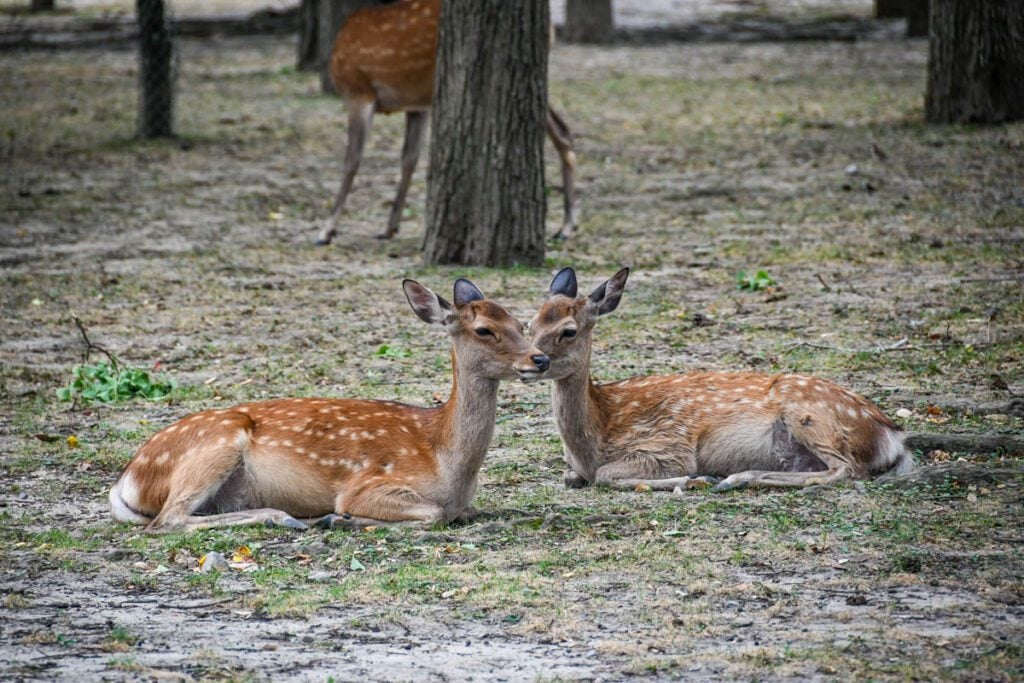
Nara deer inhabit the park year-round. They don’t hibernate or migrate, so you’ll be able to see them no matter what time of year you visit.
That said, there are a few things you’ll want to consider when deciding on the best time to visit, depending on what you want to get out of the experience.
Spring
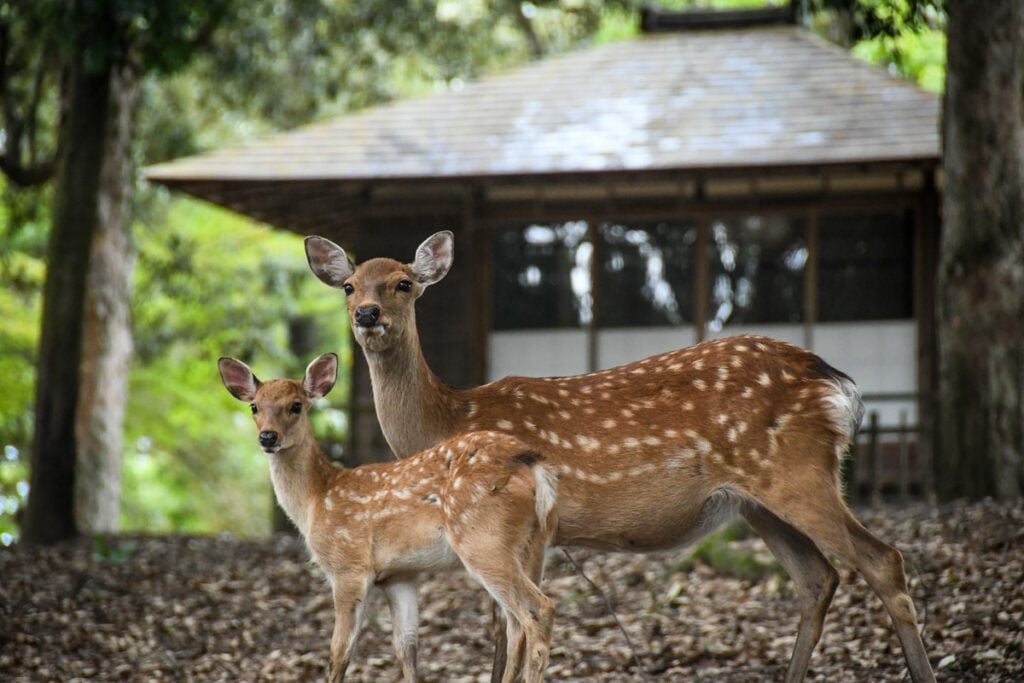
I know what you’re thinking and the answer is yes – spring means baby deer in Nara Park!
Does give birth mid-May to Mid-July, with most births in mid-June. The mothers and their newborns are taken to Rokuen, a special center for the protection and rehabilitation of injured deer, where they will stay until the fawns are old enough to follow their mothers.
In June, you can see fawns at Rokuen between 11 a.m. and 2 p.m. daily.
In addition to spotting baby deer, spring is a popular time to visit Nara Park to see the famous Japanese cherry blossoms in bloom.
Summer
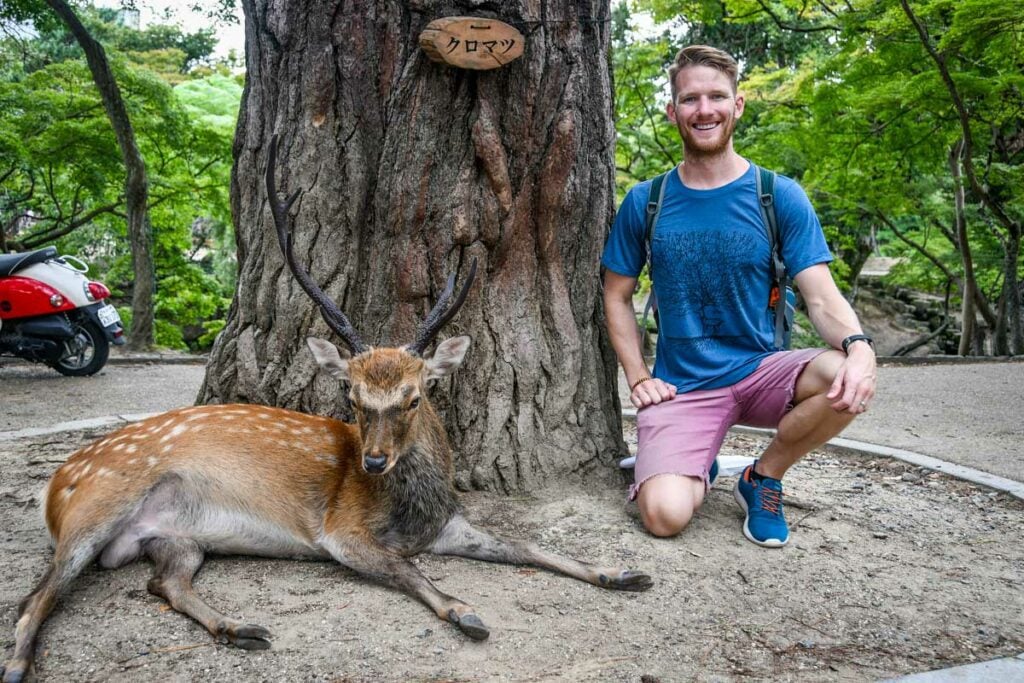
Summer in Japan is hot and humid, which may make the deer less active, especially around midday. If you’re visiting in summer, we recommend staying in Nara overnight so you can enjoy the cooler mornings and evenings.
However, summer can be a good time to visit to see antlers. The growth cycle begins in April and by August, males have elongated antlers with several points.
Fall
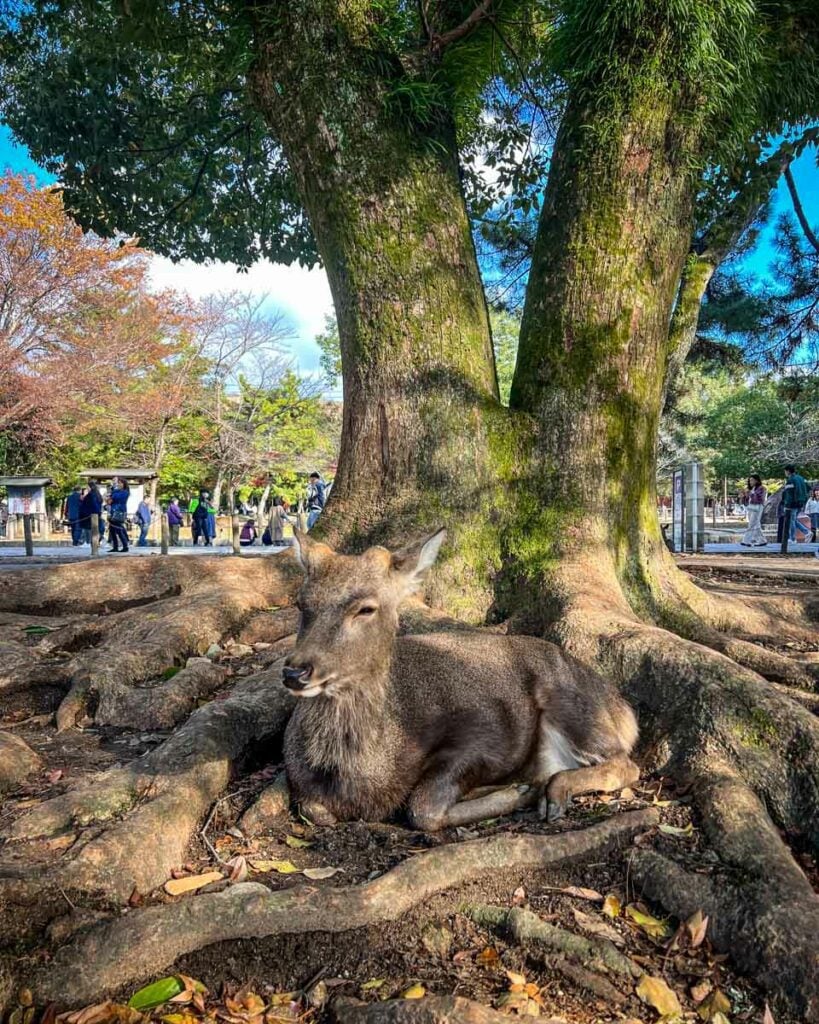
Visiting Japan in autumn was a bucket-list trip for us, and Nara was no exception. Fall foliage around Nara Park is stunning, and comfortable temperatures mean the deer are more active during the day.
Actually, Nara deer—particularly males—are getting very active at this time of year, if you know what I mean.
Fall is rutting season, so you may see some deer lovin’. Males are more aggressive during the rut, so use extra caution, especially if you’re visiting with little ones.
Nara Shika no Tsunokiri, or “deer antler cutting ceremony”, also takes place in October. While this isn’t something we personally would want to witness, it is a longstanding tradition that some may find interesting.
Winter
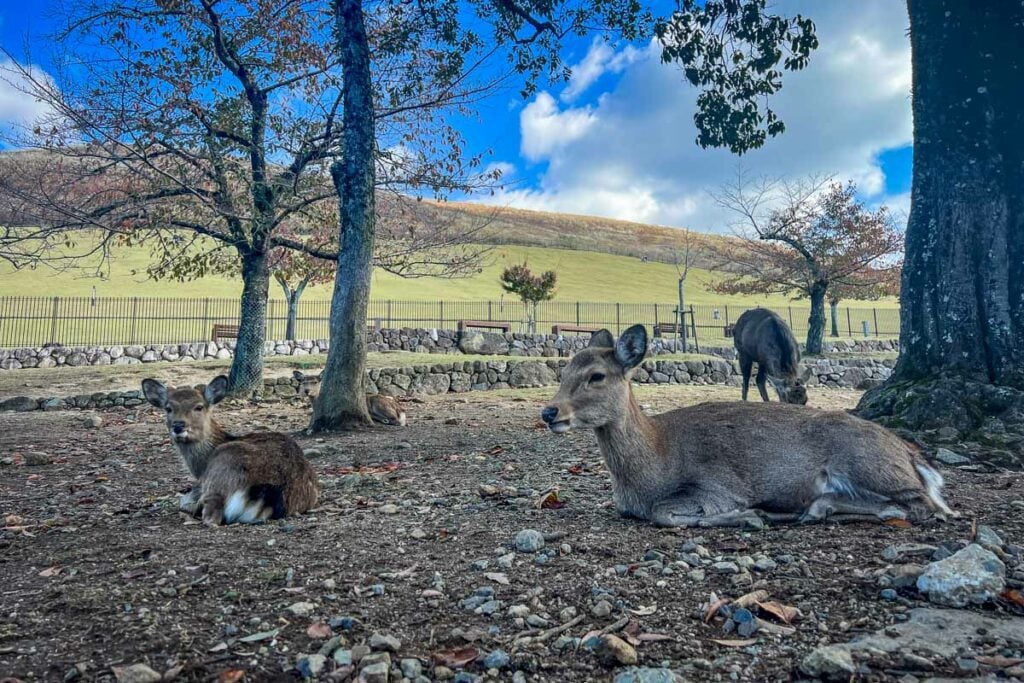
If you’re hoping to see Nara deer dressed in their signature white spots, winter is not the time.
Females’ winter coats are a brownish-gray, while males are dark brown with thick, mane-like hair down the backs of their necks.
Conversely, winter in Japan is beautiful and could be a great time to avoid the huge tourist crowds at Nara Park, as well as a good time for budget travelers to take advantage of low-season pricing.
Nara Deer FAQs
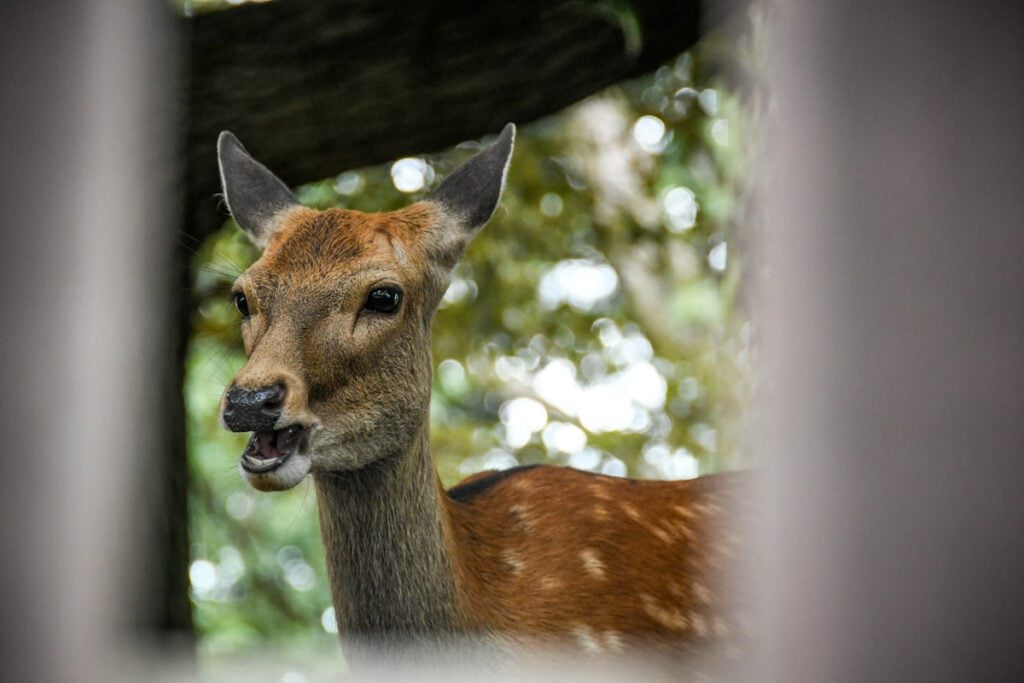
Still have questions about the deer in Nara? We’ve got answers!
How much does it cost to enter Nara Deer Park?
Nara Deer Park is free to enter.
Costs to think about:
- If you’d like to purchase deer crackers, they cost ¥200 ($1.40 USD) for a pack of 10.
- If you visit any temples or gardens, you’ll likely have to pay an entry fee. For instance, the most famous temple in Nara is Todai-ji, which costs ¥600 ($4 USD) to enter.
How many deer live in Nara Deer Park?
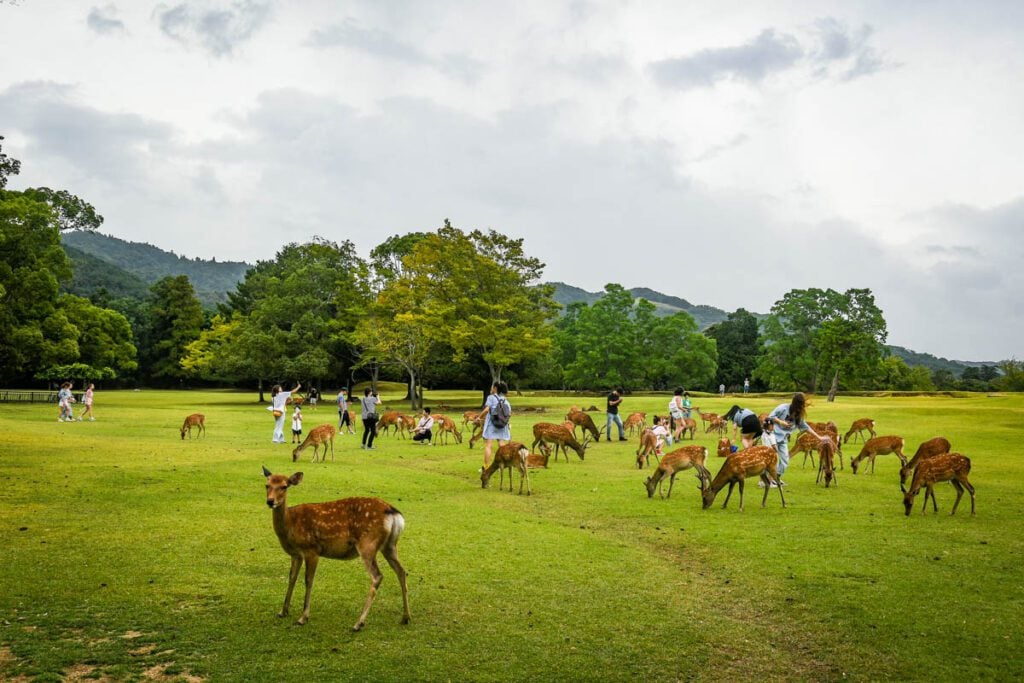
Nara tourism estimates that there are around 1,400 deer living in and around Nara Park.
Why are the Nara deer sacred?
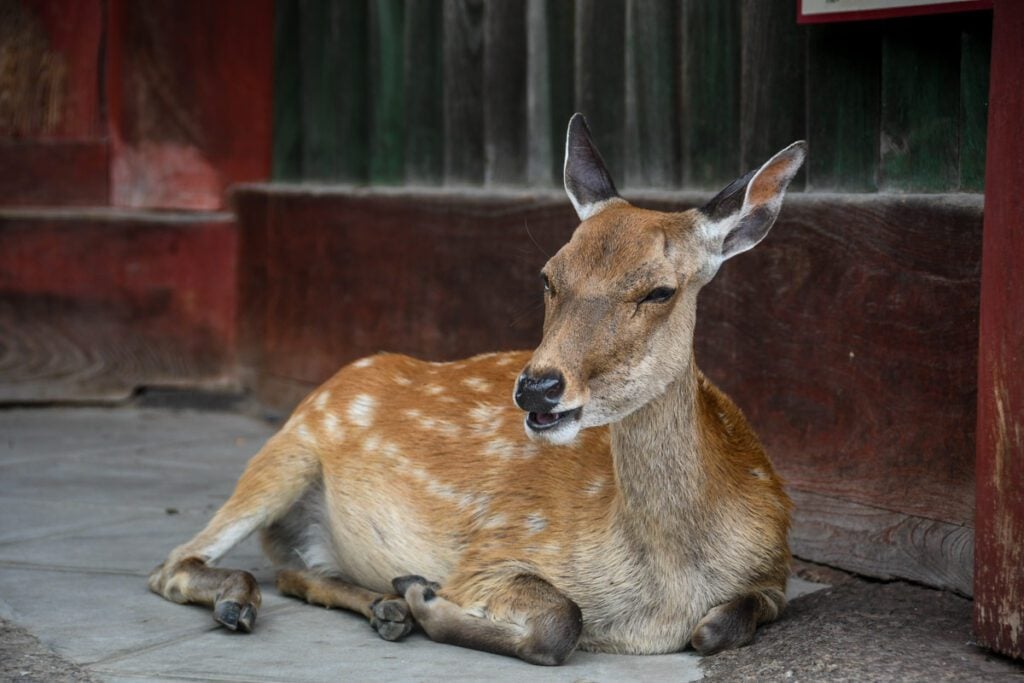
According to Shinto tradition, the deer who populate Nara are sacred messengers of the gods.
The belief comes from a legend that says the god Takemikazuchi-no-mikoto rode from Ibaraki Prefecture (just north of Tokyo) all the way to the top of Nara’s Mt. Mikasa on the back of a white deer.
Are deer in Nara aggressive?
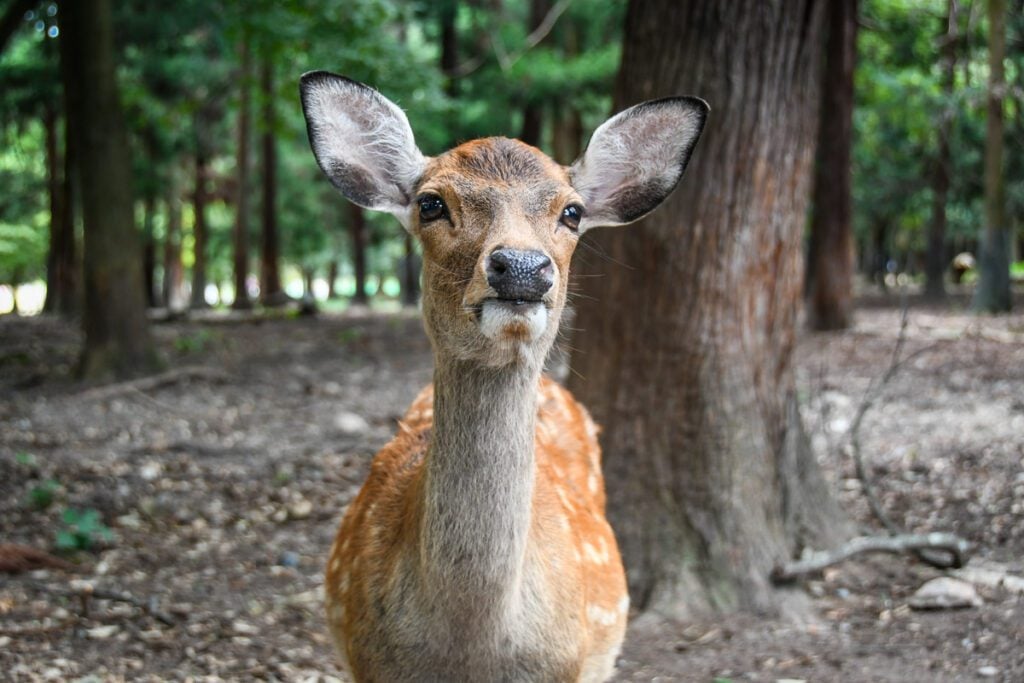
It is crucial to remember that the deer in Nara, though typically friendly, are wild animals.
Just as a pet cat or dog will scratch or bite if it feels threatened, Nara deer may become aggressive if teased or harassed. Some might be aggressive even if you’re not bothering them, just because they want food. Hey, we all get hangry sometimes.
We also noticed that deer in areas with higher tourist traffic seemed generally more aggressive than the deer in quieter areas of the park.
What do the deer eat?
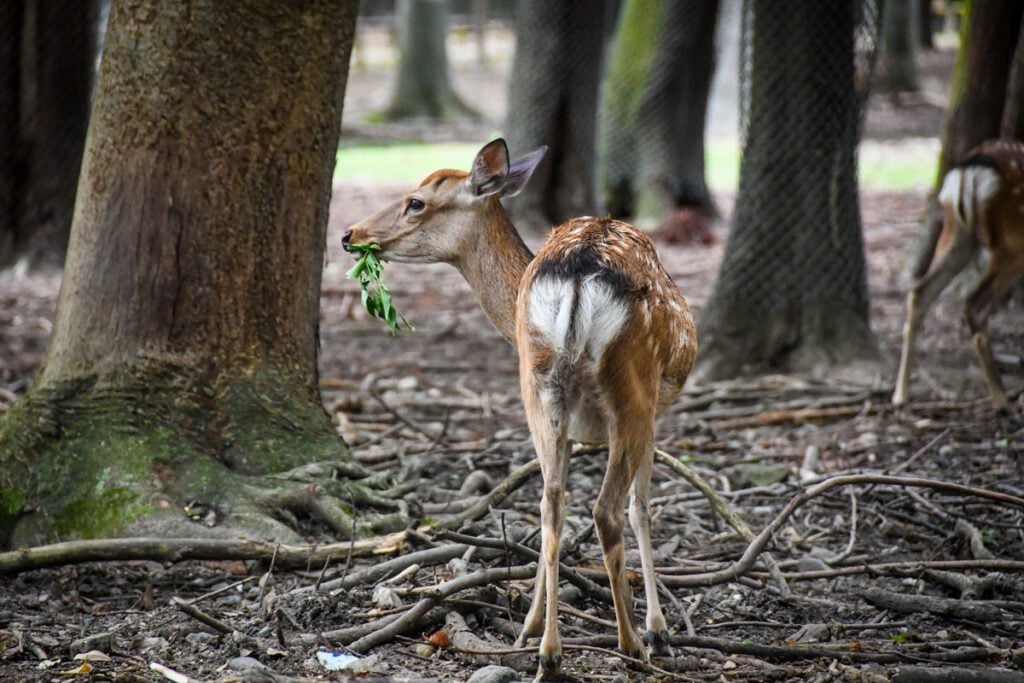
The Nara deer’s natural diet consists mainly of plants and nuts. Their staples are Noshiba, or Japanese lawn grass, and other grasses they can easily digest.
Of course, then there are the famous crackers that tourists buy to feed to the deer. Although the crackers are specially formulated to be safe for the deer to eat, they are meant to be a snack, not a staple. And with tourist numbers on the rise in Nara, the deer are eating more and more crackers.
If you choose to buy crackers to feed the Nara deer, we recommend getting away from the highly-trafficked areas where deer may be overfed.
Why don’t Nara deer have antlers?
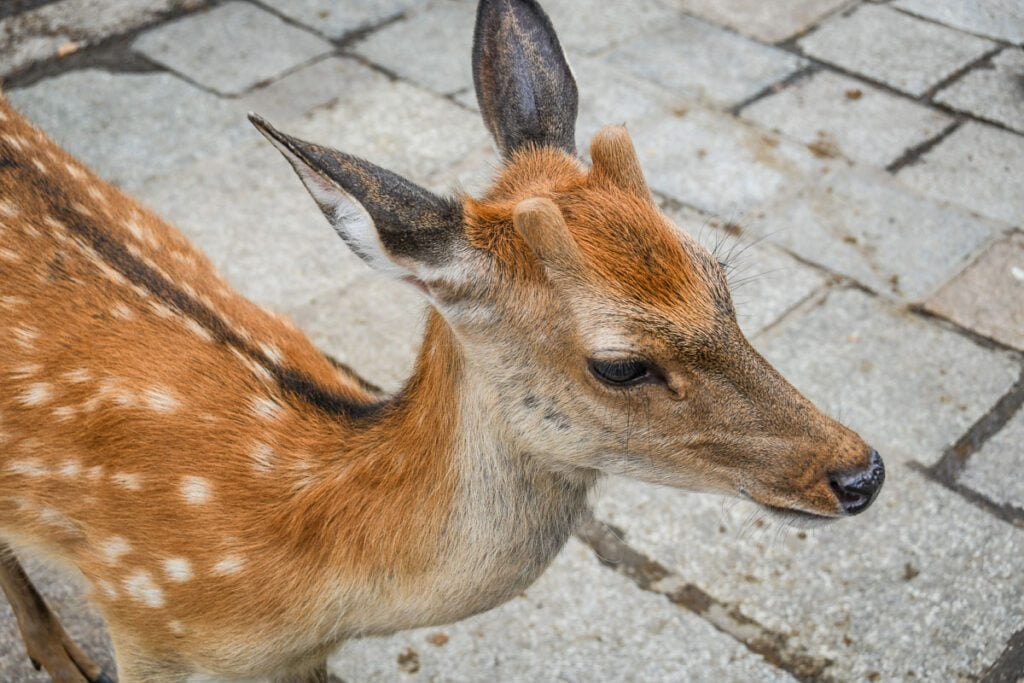
Though we have seen some male deer with antlers in Nara, you might notice that the majority have, at most, little nubs in place of pointed antlers. This is because their antlers have been cut in a ritual that goes back for centuries.
The ceremony, called Nara Shika no Tsunokiri, began in 1672 to reduce the chance of injury to humans (and other deer) from rutting males. It continues every autumn as both a safety measure and cultural tradition.
As you can imagine, this is somewhat of a controversial practice. We personally wouldn’t want to see it, but the ceremony is open to tourists.
Are Nara deers domesticated?
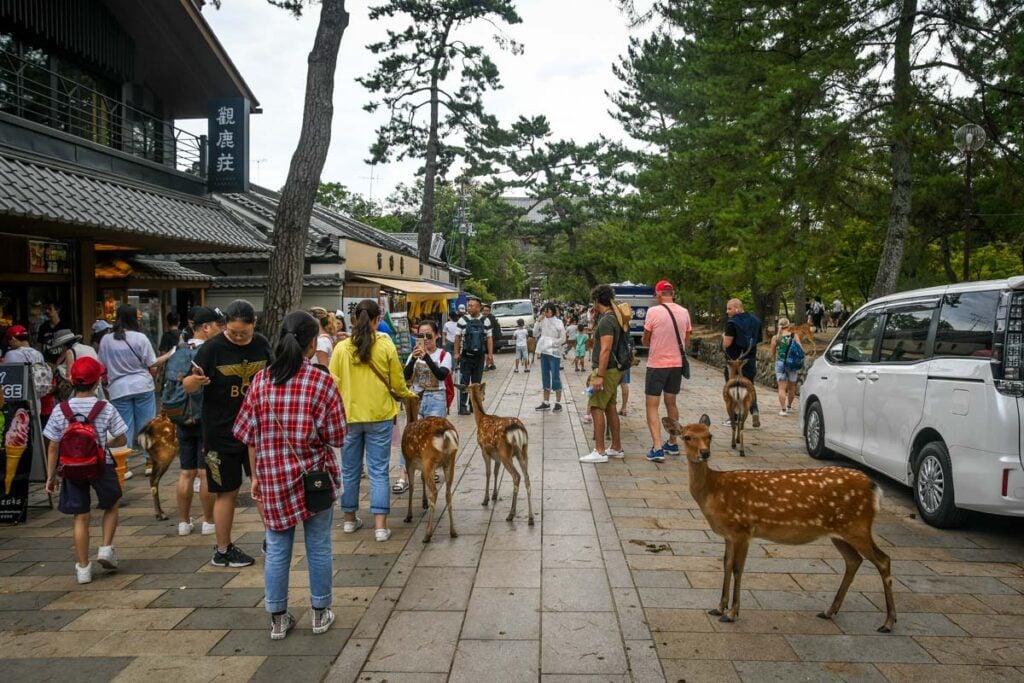
Though they’re not domesticated per se, Nara deer have been living alongside humans for centuries’ worth of generations and are well used to sharing space with humans.
Is Nara Deer Park child friendly?
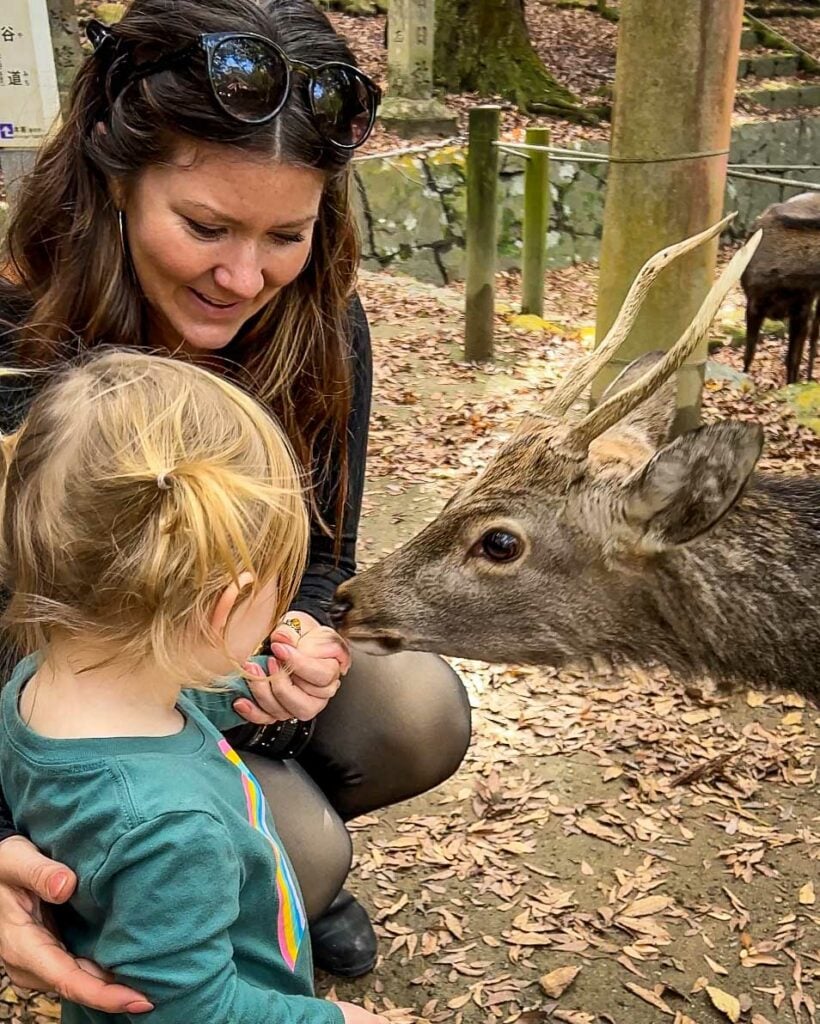
Absolutely!
We brought our daughter, who was 2 years old at the time of the trip, and she loved seeing the friendly deer.
I would say that it is very important that you have an eye on your child at all times because the deer are wild and you should only approach them very carefully.
Planning a family trip to Japan? You’ll definitely want to read our ultimate guide for traveling in Japan with kids!
Is it ethical to feed the deer in Nara?
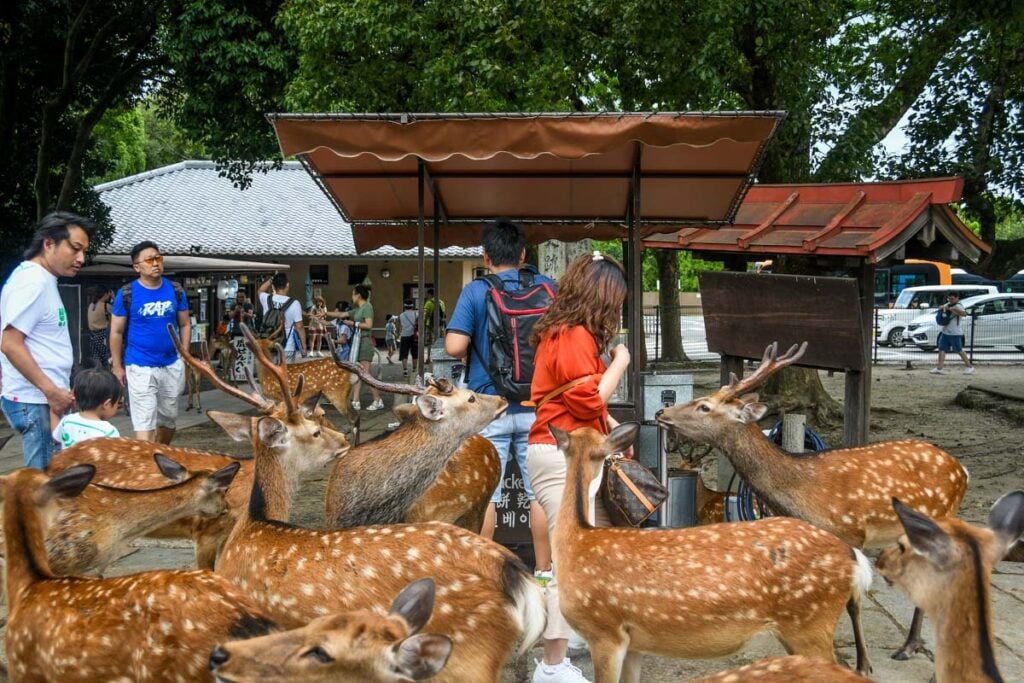
This is a tough one to answer. This is a complex issue and I’m no expert, but here are some thoughts…
In truth, any situation where animals are regularly interacting with humans is not 100% ethical.
It’s really hard to find much information with evidence about the ethics of the deer living in Nara, as they have been living amongst people for centuries.
Unlike other wild deer around the world that are born in the wilderness, the deer in Nara have all been born into a special situation where they are considered sacred and allowed to roam freely in areas where people frequent. (Kind of like cows roaming about in India.) So they are somewhat different from the deer we’re used to at home.
On one hand, they are considered sacred and are highly respected. There are no fences (other than those in a section for injured deer to be able to heal without human interaction). They can come and go as they please, and the deer crackers have been specially formulated for them (and some profits from their sales go back to conservation efforts).
On the other hand, we are always wary of animal encounters that involve feeding and this is no exception.
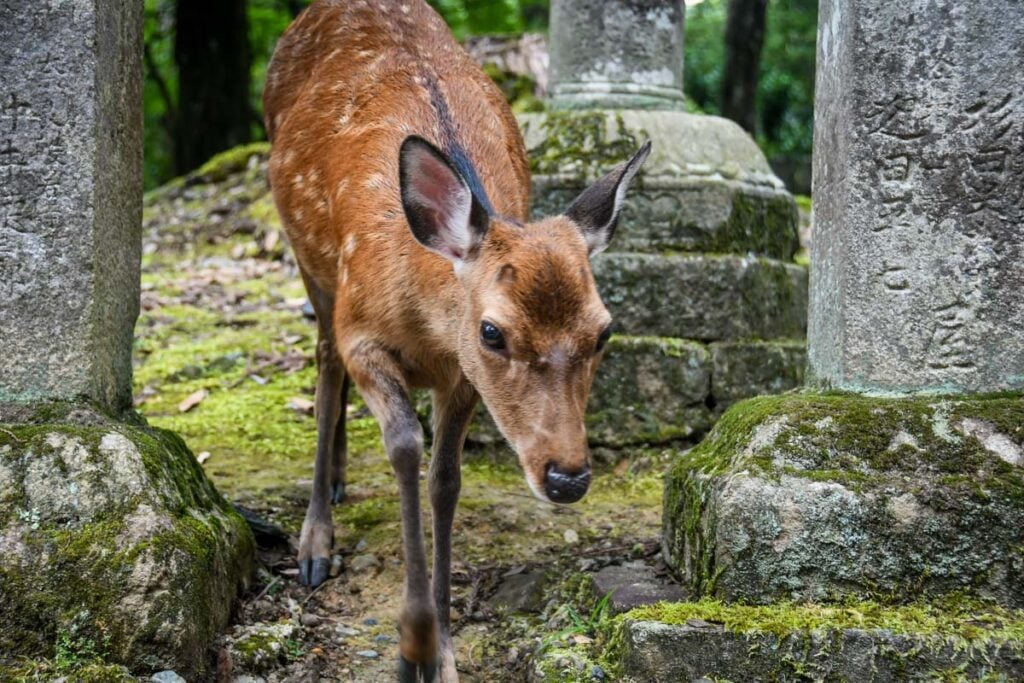
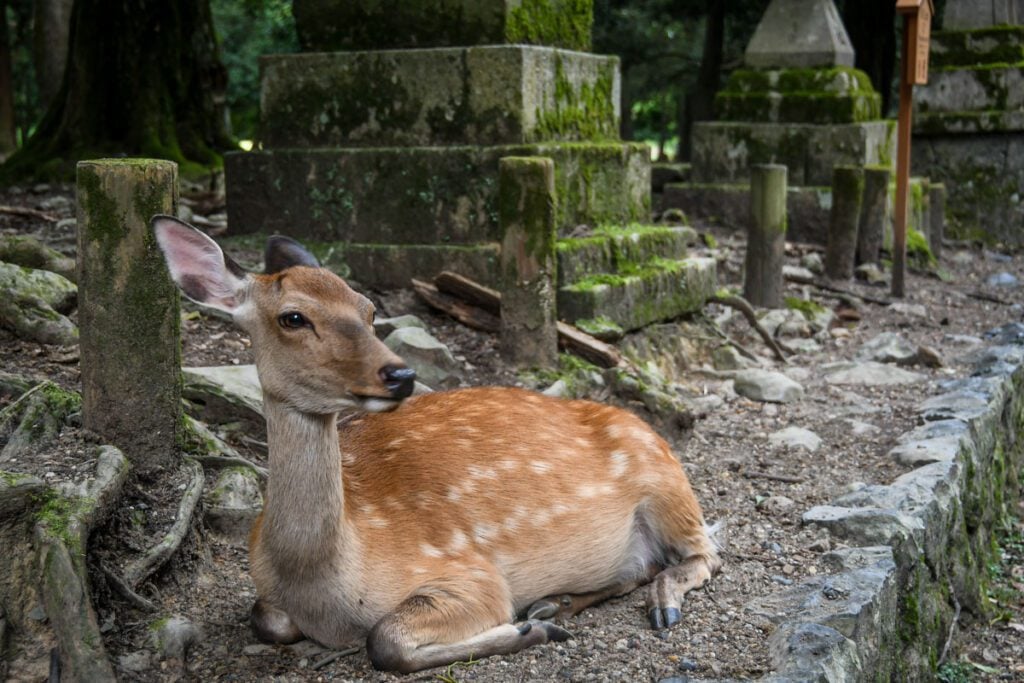
During our first visit to Nara, we chose not to feed the deer, and we still had a great time. I don’t think we really missed out on much.
During our second visit, we purchased a pack of deer crackers and fed some deer which was fun for our 2-year-old daughter to see.
That said, near the main walking street, some of the deer looked overfed, and I have doubts that this is truly the healthiest life for them. Personally, I’m unsure if I would feed them again.
I came across some threads posted during the pandemic saying some of the deer that have become reliant on people feeding them had become emaciated when tourists were no longer around. Now, tourists are flocking to the area, so the pendulum has swung in the other direction.
There’s also the ethics of the antler cutting ceremony that takes place each October. This is a cultural ritual to protect the deer from each other during fights, as well as tourists. However, I can’t help but think this is certainly not what would happen in the wild.
What are your thoughts on this topic? I’d love to hear them in the comments below!
What else is there to do in Nara?
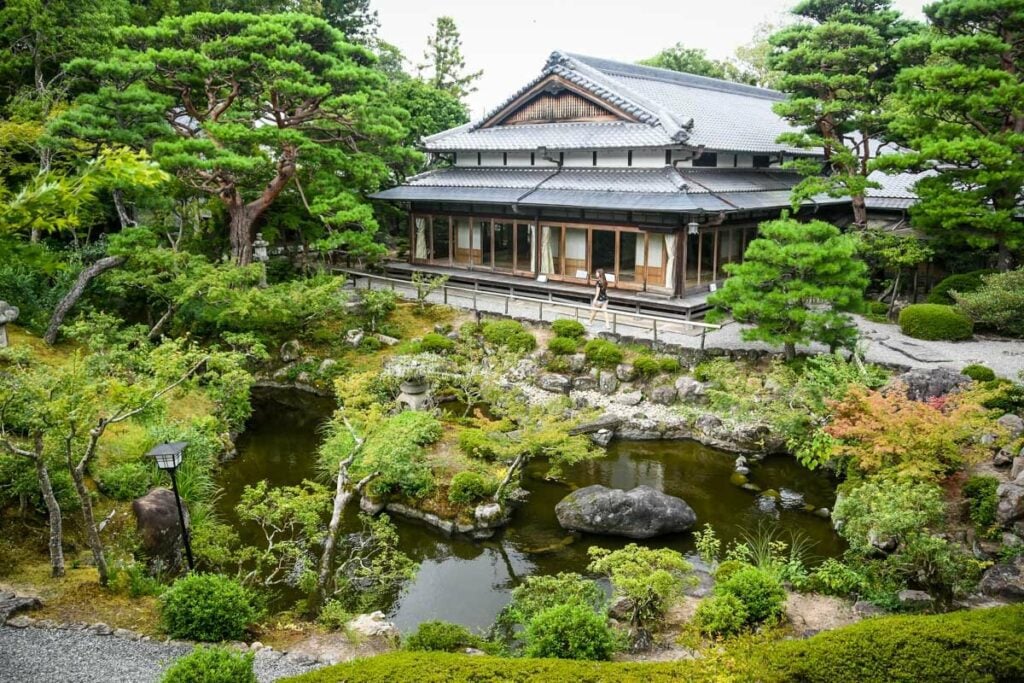
A lot, actually! Nara was the first permanent capital of Japan, so there is a rich history and it is home to some of the country’s oldest and largest temples.
There’s also some really great food in Nara.
We created the perfect Nara day trip itinerary, with all sorts of tips and hidden gems you won’t want to miss.
Plan your trip to Japan
After 3 trips (and counting!), we’ve fallen head over heels for Japan—and we’ve created TONS of resources to help you plan your dream trip. Start with our Ultimate Japan Travel Guide and be sure to check out these helpful articles:
- First time? Our Japan Trip Planner walks you through everything you need to know.
- Use our Japan Rail Pass guide to determine if getting a train pass is optimal for your trip.
- Here’s our curated list of the best things to do in Japan—from iconic sights to once-in-a-lifetime experiences.
- Not sure where to go? Our Japan itinerary ideas will help you map it all out.
- Foodies, rejoice! This guide to what to eat in Japan will have you drooling before you land.
- This guide to what to wear in Japan (and what not to wear) will help you blend in.
- Use our ultimate Japan Packing List to make sure you don’t forget anything.
- Before you go, brush up on these essential Japan travel tips (including major do’s and don’ts!).
- Avoid awkward moments by brushing up on Japanese etiquette.
Still have questions? Drop us a comment—we LOVE helping travelers plan unforgettable trips to Japan!
Perfect Japan itinerary
Want the perfect itinerary planned for you?

If you don’t have a ton of time to spend planning your Japan itinerary (or you just don’t find travel planning fun), we’ve got something you might be interested in…
We created the ultimate done-for-you Japan itinerary that is packed full of all sorts of tips we’ve gathered from 3 trips to Japan as well as literally hundreds of hours of research (no exaggeration).
We have both an off-the-beaten path route as well as a classic itinerary that hits the top attractions (perfect for your first visit to Japan!).
Don’t miss your chance to grab our Japan packing list!
This FREE PDF download includes everything you’re going to want to pack for your Japan trip, including what NOT to bring, plus tons of insider tips!
Just enter your email and we’ll immediately send you access instructions!
Save this article on Pinterest for later!
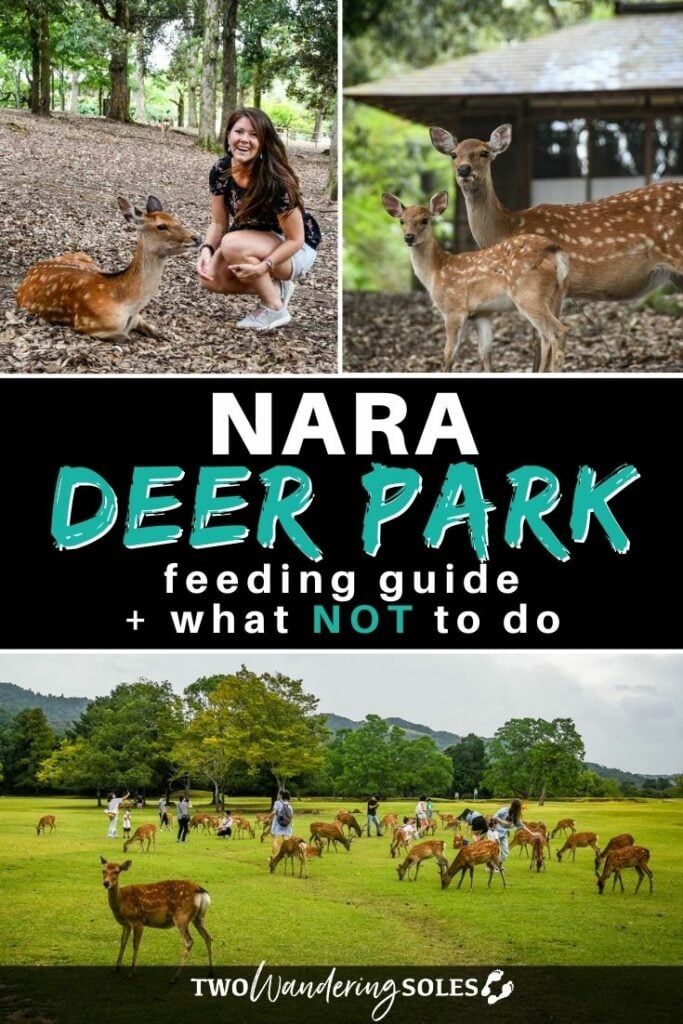
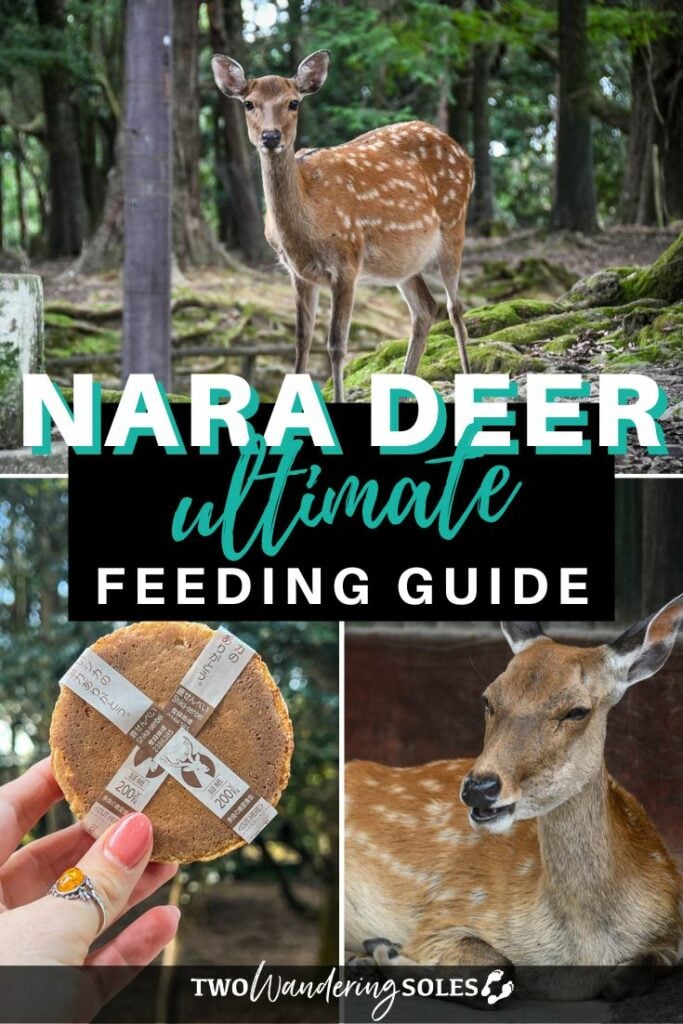
We want to hear from you!
Have you been to Nara before? Do you have any questions or opinions on feeding the Nara deer? We’d love to hear your thoughts in the comments below!


